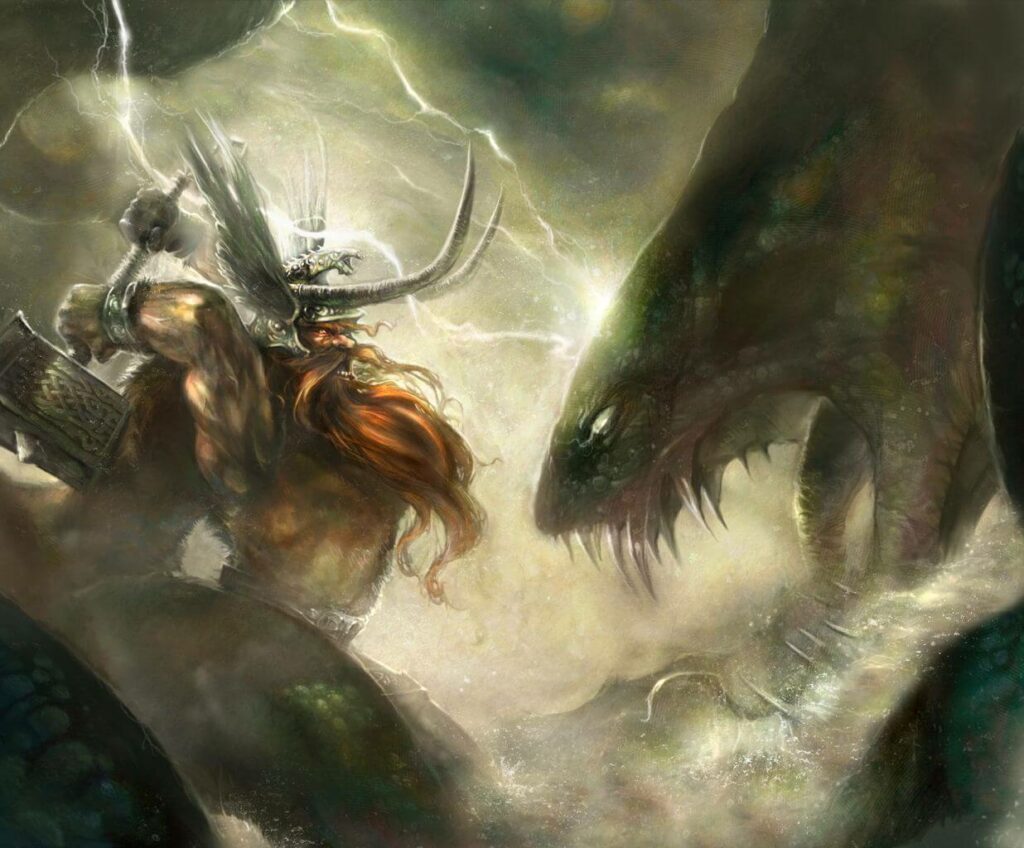

Once upon a time, Jormungand would live in Angraboda's house, but that was before the Gods found out about Loki's affair (he was married to Sigyn, not Agraboda). His older brother is the daemon wolf, Fenrir (Fenris) and his younger sister are Hel, who is half a beautiful woman and half a corpse (sometimes the split is down the middle, sometimes at the waist.) Jormungandr is the son of the Trickster God, Loki, and a giantess, Angroboda, and is the middle child of his strange family. Jörmungandr's arch-enemy is the thunder-god, Thor. When it releases its tail, Ragnarök will begin. As a result, it received the name of the Midgard Serpent or World Serpent. The serpent grew so large that it was able to surround the earth and grasp its own tail. The Jormungandr figure in Norse myth was illustrated as a serpent-like creature, his appearance resembled a dragon a lot though. Like most giant world-hugging snake-dragons he holds his tongue in his mouth as a symbol of eternity. He is a mighty dragon that encircles the world, stopping the sea from falling over the edge. Jormungandr – The Mortal Enemy of ThorĪlso spelled: Jormungand, Jormungander, Jormungond etc, and also known as the Midgard Serpent, or Midgard Serpent. It is so powerful that no gods can conquer it even Ragnarok could not affect it. Nidhogg is considered to be the strongest mythical animal in Norse Mythology. And it’s impossible even how huge the dragon is. At first, Nidhogg ate the roots of Yggdrasil to live, however, after the encounter with Vedrfolnir - a mighty eagle lived on the top of Yggdrasil, it is crazy to destroy the Yggdrasil roots to prove its strength. The origins of Nidhogg - The symbol of deathĪs mentioned above, Nidhogg lived under Yggdrasil, deep down Helheim - one of the Nine Realms of the World Tree. These depictions are understandable because Nidhogg was a dragon living at the root of the Yggdrasil - the World Tree connecting the Nine Worlds. His body encompassed the roots of Yggdrasil with its deadly jaws open and intending to eat corpses and roots. Thus, its name might refer to its role as a horrific monster in its action of chewing the corpses of the inhabitants of Náströnd: those guilty of murder, adultery, and oath-breaking, which Norse society considered among the worst possible.Īccording to many depictions, Nidhogg was a giant dragon with evilly shining eyes in the darkness. In historical Viking society, níð was a term for a social stigma implying the loss of honor and the status of a villain. In Norse mythology, Níðhöggr ( Malice Striker, traditionally also spelled Níðhǫggr, often anglicized Nidhogg ) is a dragon/serpent who gnaws at a root of the world tree, Yggdrasil. Níðhöggr - the most powerful dragon in Norse mythology Below we will introduce you three dragons that appeared in Norse mythology: Jormungandr, Nidhogg, and Fafnir. Norse Myth Dragons represent the powerful forces of destruction and a great force of evil. The dragons in the modern sense are not totally evil, though in the sense they embodied it was something related to danger, natural chaotic forces, and unpredictable thoughts. Moreover, they are in possession of extraordinary prowess which words could barely explain. They are famous for their splendid and sometimes fearsome appearance. If you are a massive fan of the Dragon and Norse Mythology, this article will help you figure out “Dragon in Norse Mythology” in all angels from origins and meanings.ĭragon has been a long time known as the most powerful mystical creature in Norse mythology.


 0 kommentar(er)
0 kommentar(er)
